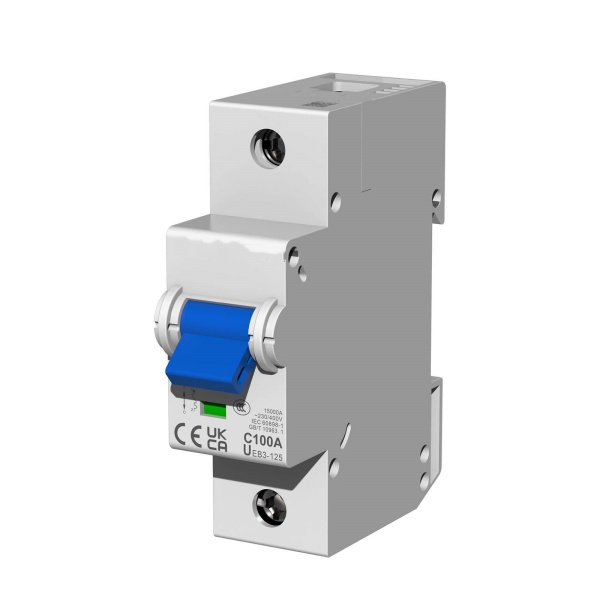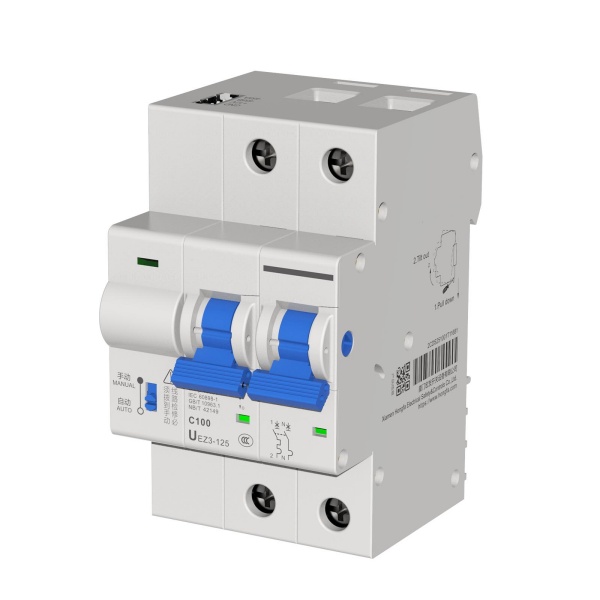Miniature circuit breakers, referred to as MCBs, have been around for more than a century and have been replaced by successive generations. Today, they have developed into the appearance shown in the figure below. According to the use of DC and AC current systems, they can be divided into DC type miniature circuit breakers and AC type miniature circuit breakers. DC circuit breakers use more complex arc extinguishing and current limiting systems than AC types. The basic structure of a miniature circuit breaker includes a housing, inlet and outlet wiring points, main contacts, electromagnetic coils, bimetallic thermal elements, arc extinguishing chambers, opening and closing mechanisms, opening and closing status indicators, and installation mechanisms. Today I will share with you the A/B/C/D types of miniature circuit breakers.

UEB3-125 MCB Miniature Circuit Breaker
Ⅰ. Miniature Circuit breakers generally have four tripping characteristics, namely A, B, C, and D
A-type circuit breaker: 2 times the rated current, rarely used, generally used for semiconductor protection (generally using fuses)
B-type circuit breaker: 2-3 times the rated current, generally used for pure resistive loads and low-voltage lighting circuits, often used in household distribution boxes, protecting household appliances and personal safety, currently less used.
C-type circuit breaker: 5-10 times the rated current, needs to trip within 0.1s, and circuit breakers with this characteristic are most commonly used to protect distribution lines and lighting lines with large connection currents.
D-type circuit breaker: 10-20 times the rated current, mainly used in electrical environments with large instantaneous currents, and is rarely used in general households. It is suitable for systems with large inductive loads and large impact currents, and is often used to protect equipment with large impact currents.
The so-called multiple current: it is anti-impact current. The switch does not trip within a certain period of time. Its characteristic is to avoid impact current.
Ⅱ. Selection of low-voltage circuit breaker tripping type
The circuit breaker tripping types include overcurrent tripping, undervoltage tripping, parallel tripping, etc.
Overcurrent release: It can be divided into overload release and short-circuit current release, with long delay, short delay and instantaneous, and overcurrent release is the most commonly used.
The setting value of the overcurrent release action current can be fixed or adjustable, usually adjusted by rotating or adjusting rod. There are two electromagnetic overcurrent release methods: fixed and adjustable. Electronic overcurrent release is usually adjustable.
The breaking capacity of the circuit breaker: refers to the ability to withstand the maximum short-circuit current, so the breaking capacity of the rotating circuit breaker must be greater than the short-circuit current of its protection device.
The overcurrent release is divided into fixed installation and modular installation according to the installation method. The fixed device is processed into a whole when the circuit breaker and the circuit breaker leave the factory. After the product leaves the factory, the rated current of the releaser is not adjustable. The modular installation releaser is used as an installation module of the circuit breaker, which can be adjusted at any time and has strong flexibility.
Instantaneous type: 0.02s, for short circuit protection;
Short delay type: 0.1-0.4s, for short circuit and overload protection;
Long delay type: less than 10s, for overload protection;
The commonly used DZ series air switches (small circuit breakers with leakage protection) have the following specifications:
C16, C25, C32, C40, C60, C80, C100, etc., where C represents the tripping current characteristic of C, that is, the tripping current, such as C20 represents the tripping current of 20a, and the tripping characteristic is the C curve. 3500W water heater installation generally uses C20 circuit breakers, and 6500w water heater installation generally uses C32 circuit breakers.
Circuit breakers are used to protect wires and prevent fires, so they should be selected according to the size of the wires rather than the power.
If the circuit breaker is too large, it cannot protect the wires. When the circuit breaker is overloaded, it still does not trip, which poses a hidden danger to family safety.
1.5 square wire with C10 switch.
2.5 square wire with C16 or 20 switch.
4 square wire with C25 switch.
6 square wire with C32 switch.
For air switches with motors as loads, D-type characteristics should be selected to avoid high starting currents of 5-8 times the motor starting current.
As a key protection element in the power system, the correct selection of miniature circuit breakers is essential to ensure circuit safety and prevent equipment damage and fire. Through today’s sharing, we learned that the A, B, C and D types of miniature circuit breakers each have different tripping characteristics, suitable for different electrical environments and load requirements. Type A circuit breakers are less used due to their special uses, while Type B circuit breakers are suitable for purely resistive loads and low-voltage lighting circuits, although they are not used much at present. Type C circuit breakers have become the most commonly used choice due to their wide applicability and fast tripping characteristics, especially for distribution lines and lighting lines with large currents. Type D circuit breakers are designed for systems with large inductive loads and large inrush currents, and are suitable for protecting equipment with high starting currents.

UEZ3-125 Intelligent Miniature Circuit Breaker
When selecting a circuit breaker, in addition to considering its tripping characteristics, factors such as the opening type, breaking capacity, release type and installation method need to be considered. The setting value of the overcurrent release can be fixed or adjustable, providing flexibility and adaptability. Instantaneous, short-delay and long-delay releases are used for short-circuit protection, short-circuit and overload protection, and overload protection respectively to meet different protection needs. The correct selection of miniature circuit breakers is a highly technical task that requires comprehensive consideration of multiple factors. With the continuous advancement of technology and the diversification of electrical system requirements, the design and application of miniature circuit breakers are also constantly developing and improving to meet higher standards of safety and efficiency requirements.
Post time: 7 月-22-2024


